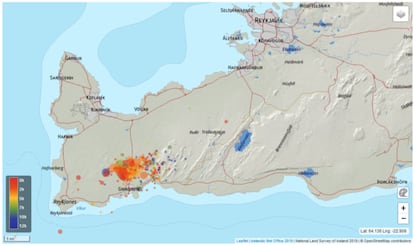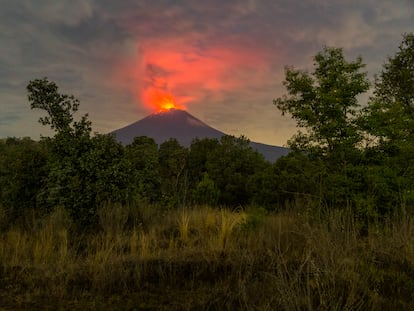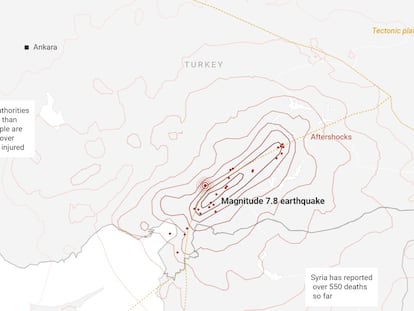What is happening in Iceland? Thousands of earthquakes herald a volcanic eruption
The seismic swarm in the southeast of the island has registered 1,000 earthquakes a day, and land deformation in the area has been observed from space
Iceland expects a large volcanic eruption. They don’t know when it will come, but it is coming. Since the end of October, the there have been constant earthquakes in the southwest of the island. In that same area there have already been other volcanic eruptions, like the one last summer. But this time, with the land tearing open up for miles, they fear it will be one they will remember.
What is happening?
On October 24, the ground began to shake in the southwestern part of the island. In a country as volcanic as Iceland, with more than 200 active volcanoes, the fact that the earth is shaking does not affect Icelanders’ the daily lives. But the number of small earthquakes has continued to increase. They are now being produced at a rate of more than a thousand a day. This is what is known as a seismic swarm. A similar phenomenon, but on a much smaller scale (barely a hundred tremors), preceded the eruption on La Palma in Spain’s Canary Islands in September 2021. And what the Icelandic authorities fear is that one of the volcanoes in the region will erupt.
Where are the quakes being felt?
The epicenter of the earthquakes varies, but they are all occurring in a wide area around the town of Grindavík, in the southwest of the island. It is a small fishing municipality located on the Reykjanes peninsula, just 60 kilometers (37 miles) from Iceland’s capital city, Reykjavík. At the beginning of the event, the swarm was concentrated to the west of the affected area, but later moved to the east. Over the weekend, the earthquakes moved again, concentrating south of Grindavík. The quakes are so far south that if the earth opened at that point, it could lead to an underwater eruption. As for depth, the tremors began occurring at more than five kilometers (3.1 miles) below the surface. But on November 9 they were already at 3.5 kilometers (2.17 miles), and in recent days they have been happening at just 800 meters (2,624 feet).

What is happening beneath the surface?
The changes in the position of the seismic swarm and the rise of the hypocenter have led those responsible for monitoring its development and the Icelandic Meteorological Office (IMO) to determine that a magma intrusion would be occurring. The mass must be enormous, with the entire area being on top of it. Bill McGuire, emeritus professor of geophysical and climate hazards at University College London, told the Science Media Center that models suggest that “magma is rising along a 15-kilometre-long fracture and is now as close to the surface as 800 meters or even less.” From space, GPS has detected a rise in the terrain of several centimeters a day in various points in the area.
Where will the magma emerge?
Scientists do not know where the magma will emerge. But the fracture, which has opened from southwest to northeast, is a clue. According to the IMO, it will do so at some point in the crack. Experts relate this event to the nearby Fagradalsfjall volcano, which has been accelerating its activity since 2021 and whose last eruption was last summer. Therefore, there is a possibility that the material will end up emerging at this point. What scientists do not know is when. In their latest notes, what the IMO have said most often is that “the probability of a volcanic eruption in the coming days is high.”
Will there be a volcanic eruption?
If experts do not know where a mass of molten earth will emerge, they know even less what type it will be. The alternatives are several. The area is relatively flat and the volcanoes do not have the typical cone shape. In that part of the island — and Fagradalsfjall is a good example — the land opens up with volcanic fissures. In this case, the lava flows from a point in the crack and does not have to be explosive in nature. If it emerges far south of the fissure, it would be in the sea. But an explosive eruption at an uncracked point cannot be ruled out.
Why are there so many earthquakes and volcanic eruptions in Iceland?
The meeting between the North American and Eurasian tectonic plates occurs in the middle of the North Atlantic (something similar also happens in the south, but with other plates). To be honest it is not a meeting, but a disagreement: both plates are separating. Along the ocean, from south to north, an enormous fissure called the mid-Atlantic ridge has opened in the seabed. Although the gap is at the bottom of the sea, thousands of feet underwater, it also crosses land. And what land does it cross? Iceland, which it splits in two.
What impacts can it have?
The authorities have declared a state of alert in Grindavík, but have not yet ordered the evacuation of the town, but of some nearby villages. In the event of an eruption, there is a risk due to toxic fumes, particularly sulfur dioxide. On a global scale, the greatest risk would come from the ash column that could be ejected. That is why, because of the spherical shape of the Earth, planes from Europe to North America fly far to the north, which is to the south of Iceland. An explosive eruption could emit large quantities of particles that disrupt Atlantic air traffic. This is what happened when the Eyjafjallajökull eruption kept world aviation in check for months in 2010. But in that case, it was an eruption under the frozen mass of a glacier and it was the interaction between the lava and the ice that caused the ejection of immense quantities of particles. There is no ice on the site of the potentially new volcano, but if the eruption were to take place in the ocean, it would increase the risk.
Sign up for our weekly newsletter to get more English-language news coverage from EL PAÍS USA Edition
Tu suscripción se está usando en otro dispositivo
¿Quieres añadir otro usuario a tu suscripción?
Si continúas leyendo en este dispositivo, no se podrá leer en el otro.
FlechaTu suscripción se está usando en otro dispositivo y solo puedes acceder a EL PAÍS desde un dispositivo a la vez.
Si quieres compartir tu cuenta, cambia tu suscripción a la modalidad Premium, así podrás añadir otro usuario. Cada uno accederá con su propia cuenta de email, lo que os permitirá personalizar vuestra experiencia en EL PAÍS.
¿Tienes una suscripción de empresa? Accede aquí para contratar más cuentas.
En el caso de no saber quién está usando tu cuenta, te recomendamos cambiar tu contraseña aquí.
Si decides continuar compartiendo tu cuenta, este mensaje se mostrará en tu dispositivo y en el de la otra persona que está usando tu cuenta de forma indefinida, afectando a tu experiencia de lectura. Puedes consultar aquí los términos y condiciones de la suscripción digital.
More information
Últimas noticias
Most viewed
- Reinhard Genzel, Nobel laureate in physics: ‘One-minute videos will never give you the truth’
- Oona Chaplin: ‘I told James Cameron that I was living in a treehouse and starting a permaculture project with a friend’
- Pablo Escobar’s hippos: A serious environmental problem, 40 years on
- Why we lost the habit of sleeping in two segments and how that changed our sense of time
- Chevy Chase, the beloved comedian who was a monster off camera: ‘Not everyone hated him, just the people who’ve worked with him’











































